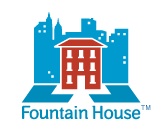Lesson 9: Social Rehabilitation and Day Treatment
Attention

A PROGRAM AND A PLACE
Fountain House is a professional self-help program, operated by men and women recovering from mental illness, in collaboration with a highly professional and caring staff. The emphasis at Fountain House is on relationships – member to member, and member to staff. Members engage with each other to regain their productivity and self-confidence, resume their lives, and re-enter society. They take part, as well, in promoting their rights, and in erasing the stigma that often separates them from their neighbors.
Since its founding in 1948, Fountain House has served a total of more than 16,000 men and women. Its innovative “clubhouse” model is today the basis for more than 400 similar programs in 32 countries around the world, assisting some 50,000 men and women. The Fountain House concept has been adopted in part by another 1,000 programs in the U.S. and abroad.
Fountain House is also a building — home base for the organization’s activities. A five-story mansion-like complex, it encompasses some 57,000 square feet, including four outdoor gardens. The building has been updated from time to time to meet the changing needs of Fountain House members and staff as they create and operate Fountain House’s diverse programs, administer the organization, tend to their lives, work and study, dine and relax, and make friends.
THE WORK
Fountain House’s programs and partnerships originate in its units. Each unit is “home base” for a number of members and staff, who work together to develop and operate a particular activity. In each unit, as well, staff members provide community support for members, to ensure that they receive the benefits and services they need, from both Fountain House and beyond.
Members volunteer their work, to make Fountain House work. Together, members and staff are able to derive a sense of accomplishment, build skills, and establish relationships, helping everyone to know that they are needed and appreciated.
Learning Outcomes
Upon completion of this lesson's material, students will be able to:
- Define psychiatric day programming
- Describe how day programming began and how it developed
- List the common elements that make up a day program
- Describe milieu therapy and how it works
Teaching
Day Programming
Day programs operate on the assumption that an environment can be created that will contribute to the rehabilitation and recovery of a person with mental illness.
Clubhouse Model
- Started with patients in NYC on the steps of the NYC Library. Developed into Fountain House. (See Box 6.2 on page 169)
- Awareness of the advantages of this model spread and other programs began to appear.
Selected Standards for Clubhouses
- Membership
- Voluntary, participation is individual
- Relationships
- Meetings are open to members AND staff, staff members are generalist
- Space
- There are no “staff only” spaces
- Work-Ordered Day
- Work is engaged by staff and members, focus on strengths, talents, and abilities, help members to gain self worth and purpose
- Employment
- Does not provide employment to members
- Does not provide employment to members
Common Elements of Day Programming
Clients
- Diagnosed with mental health diagnosis
- History of repeated hospitalization
- Should not be a danger to self/others
- Ability to tolerate the milieu
Staff
- Director
- Supervisor level staff
- Counselors/case managers
- Mental health aids
- Support staff
Space
- Normalized environment
Programming
- Socialization
- Skills training
- Social skills
- ADL’s
- Pre-vocational
- Remedial education
- Psychoeducation
International Standards for Clubhouse Programs Published by the International Center for Clubhouse Development
Other types of Day Treatment
Partial Hospitalization
- History is in the 1930’s in the Soviet Union. Patients at the hospital during the day, but not at night.
- The Community Mental Health Centers Construction Act (1963) said the CMHC’s must provide “Partial Hospitalization”.
- Gradual shift from Federal funding to funding through Medicare, Medicaid, and other funds.
- Mostly “Medical Model” type programs.
Milieu Therapy
- Every aspect of the treatment setting is used to help acieve therapeutic or rehabilitation goals.
- Has it’s roots in inpatient treatment.
Motivational Services Club Houses
Motivational Services supports both the LINC Club in Augusta and the Waterville Social Club in Waterville
Kennebec Behavioral Health Vocational Clubhouses
KBH supports Capitol Clubhouse in Augusta and High Hopes Clubhouse in Waterville
Assessment
Lesson 9 Discussion
Discuss the ways in which clients and staff interact in a club house. Is this a model that you would feel comfortable working with?
Lesson 9 Quiz
Imagine that you were in charge of programming at the agency you are working at...keeping in line with the clubhouse philosophy, day programming, and milieu therapy models address the following tasks:
- In a paragraph how would you approach teaching cooking skills at a clubhouse?
- In a paragraph how would you approach teaching about psychotropic medications at a group home (milieu therapy)?
Keep in mind that your answers have to reflect the prevailing philosophies and structures of the clubhouse and group home.